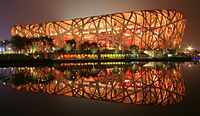Contemporary architecture
Top: Walt Disney Concert Hall by Frank Gehry; Center left: One World Trade Center by David Childs; Center right: Evolution Tower, Moscow by Philip Nikandrov; Bottom: Beijing National Stadium by Herzog & de Meuron
|
||||||
| Years active | 2000–present | |||||
|---|---|---|---|---|---|---|
| Country | global | |||||
Contemporary architecture is the architecture of the 21st century. No single style is dominant; contemporary architects are working in a dozen different styles, from postmodernism and high-tech architecture to highly conceptual and expressive styles, resembling sculpture on an enormous scale. The different styles and approaches have in common the use of very advanced technology and modern building materials, such as Tube structure which allows construction of the buildings that are taller, lighter and stronger than those in the 20th century, and the use of new techniques of computer-aided design, which allow buildings to be designed and modeled on computers in three dimensions, and constructed with more precision and speed.
Contemporary buildings are designed to be noticed and to astonish. Some feature concrete structures wrapped in glass or aluminum screens, very asymmetric facades, and cantilevered sections which hang over the street. Skyscrapers twist, or break into crystal-like facets. Facades are designed to shimmer or change color at different times of day.
Whereas the major monuments of modern architecture in the 20th century were mostly concentrated in the United States and western Europe, contemporary architecture is global; important new buildings have been built in China, Russia, Latin America, and particularly in the Gulf States of the Middle East; the Burj Khalifa in Dubai was the tallest building in the world in 2016, and the Shanghai Tower in China was the second-tallest.
Most of the landmarks of contemporary architecture are the works of a small group of architects who work on an international scale. Many were designed by architects already famous in the late 20th century, including Mario Botta, Frank Gehry, Jean Nouvel, Norman Foster, Ieoh Ming Pei and Renzo Piano, while others are the work of a new generation born during or after World war II, including Zaha Hadid, Santiago Calatrava, Daniel Libeskind, Jacques Herzog, Pierre de Meuron, Rem Koolhaas, and Shigeru Ban. Other projects are the work of collectives of several architects, such as UNStudio and SANAA, or giant multinational agencies such as Skidmore, Owings & Merrill, with thirty associate architects and large teams of engineers and designers, and Gensler, with 5,000 employees in 16 countries.
...
Wikipedia




